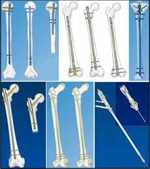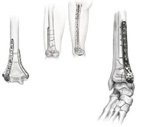Fractures & Trauma
We provide comprehensive treatment of broken bones, from non-surgical treatment of minor injuries to surgical treatment of more significant trauma. We are trained in the latest techniques, implants, and equipment. We treat all extremity fractures and minor pelvic fractures of adults and children. Unfortunately, we do not treat spine fractures, but other highly trained neurosurgeons in Texarkana provide those services. We recommend the appropriate treatment type and therapy regimen based on fracture type, literature, experience, patient's age and medical condition.
Non-Surgical Treatment
Non-surgical treatment is utilized for stable fractures and some unstable fractures. It is usually conducted in the office as a followup from visit to an emergency room or urgent care center. Stable fractures are those broken bones that we feel will not move with early motion and weightbearing. Stable fractures are usually placed in a removable brace, splint, sling, boot, or shoe for pain control and protection. Motion of the surrounding joints around a stable fracture is initiated early to reduce stiffness, sometimes under supervision of a physical therapist. Weightbearing and activities are advanced as allowed by pain. Some unstable fractures are treated nonoperative with a cast. The cast holds the bones in the desired position until the body forms enough callous to stabilize the fracture. Cast removal, advancement of weightbearing, and initiation of motion of the adjacent joints are begun when the doctor feels the bones are stable enough to avoid displacement. Casts are used for most pediatric fractures for protection of stable fractures and immobilization of unstable fractures. Unstable fractures in adults are sometimes treated with a cast, but more often treated in a surgical fashion to avoid the potential stiffness and decreased motion of adjacent joints that can occur with a cast.
 Surgical Repair Surgical Repair
Surgical repair of unstable fractures and peri-articular fractures provides immediate stability to allow early motion of surrounding joints, early weightbearing, and early rehabilitation. This is usually performed at an inpatient hospital following an emergency room visit. The goal of surgical repair is for faster return to normal activities, decreased pain, and minimization of stiffness, contractures, deformities, nonunions, and arthritis. Repair is accomplished with screws, pins, plates, intramedullary rods, external fixators, or sometimes joint replacement.
Long bone shaft fractures of the humerus, femur, and tibia are usually treated with intramedullary rods.
 Fractures around the joints, called peri-articular fractures are usually performed with a combination of screws, plates, and pins. Restoration of the articular cartilage surfaces as close as possible to normal anatomy will help minimize the development of arthritis. Newer implants and techniques have allowed smaller incisions and, in some cases, percutaneous fixation. We are well trained in all of the latest techniques and implants as well as the time tested traditional methods of surgical repair. Fractures around the joints, called peri-articular fractures are usually performed with a combination of screws, plates, and pins. Restoration of the articular cartilage surfaces as close as possible to normal anatomy will help minimize the development of arthritis. Newer implants and techniques have allowed smaller incisions and, in some cases, percutaneous fixation. We are well trained in all of the latest techniques and implants as well as the time tested traditional methods of surgical repair.
 Some fractures occur as the result of high energy trauma. These type of injuries are often treated in a staged approach, with temporary stabilization usually by external fixation, followed by later definitive stabilization when the swelling decreases and the surrounding soft tissues show a viable blood supply and coverage of the fracture site. External fixators can also be used as definitive treatment. Many high energy fractures are open fractures (ie bone exposed outside the skin). Open fractures are treated with urgent copious irrigation, antibiotics, and temporary stabilization to minimize the risks of bone infection. If we feel that a fracture has inadequate soft tissue coverage, the patient may be referred to trauma center where plastic surgeons can perform the appropriate soft tissue work. Some fractures occur as the result of high energy trauma. These type of injuries are often treated in a staged approach, with temporary stabilization usually by external fixation, followed by later definitive stabilization when the swelling decreases and the surrounding soft tissues show a viable blood supply and coverage of the fracture site. External fixators can also be used as definitive treatment. Many high energy fractures are open fractures (ie bone exposed outside the skin). Open fractures are treated with urgent copious irrigation, antibiotics, and temporary stabilization to minimize the risks of bone infection. If we feel that a fracture has inadequate soft tissue coverage, the patient may be referred to trauma center where plastic surgeons can perform the appropriate soft tissue work.
Some fractures around the shoulder and hip can disrupt the blood supply to the head of the humerus and femur, causing the ball-shaped portion of the joint to die. In these special cases, partial joint replacement, or hemi-arthroplasty, is sometimes performed to replace the ball-shaped portion of the joint. |